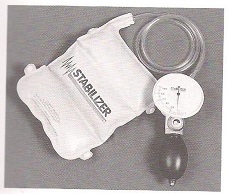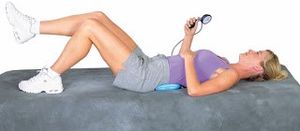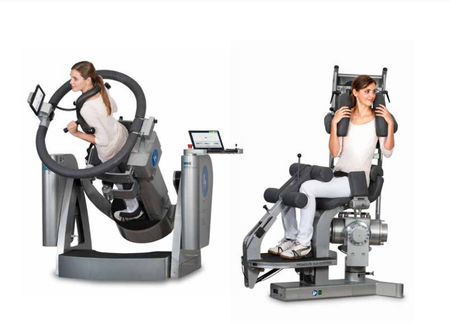Biofeedback
Original Editor - Professor Tim Watson Top Contributors - Rachael Lowe, Ellen De Boitselier, Denys Nahornyi, Simisola Ajeyalemi, Aminat Abolade, Kim Jackson, Claire Knott, Pooja Shevale, Admin, Naomi O'Reilly, Milan Matejak, Candace Goh and Angeliki Chorti
Definition[edit | edit source]
Biofeedback therapy is an instrument-based learning process that is based on “operant conditioning” techniques. The governing principle is that any behavior-be it a complex maneuver such as eating or a simple task such as muscle contraction-when reinforced its likelihood of being repeated and perfected increases several fold.[1]
Physical therapists use biofeedback to help refine a movement sequence or activation pattern to assist patients to achieve a goal. This technique involves using visual, physical and/or auditory feedback to guide the patient to give their optimal performance.[2] The ultimate purpose is that the patient gets to know his own body signs and that he can control them consciously in first place using biofeedback equipment, afterwards even without.[3]
Different types of biofeedback[edit | edit source]
Many different forms of biofeedback are currently used in the clinical setting including:
- Electromyography (EMG) - measures muscle tension
- Thermal biofeedback - measures skin temperature
- Neurofeedback/ electroencephalography (EEG) - measures brain wave activity
- Electrodermography (EDG) - measures skin electrical activity
- Heat Flux - measures the rate at which heat is being dissipated from body
- Pneumography - measures abdominal/chest movement when breathing
- Capnometry - measures end-tidal carbon dioxide
- Hemoencephalography - measures the differences in the color of light reflected back through the scalp based on the relative amount of oxygenated and unoxygenated blood in the brain
- Photoplethysmography (PPG) - measures peripheral blood flow, heart rate, and heart rate variability[4][5]
The limitations to biofeedback applications lay largely with the therapist. Given a solid understanding of the basic principles of the therapy in combination with a clinical understanding of the patients problem, there are many novel applications for the therapy.
This page will focus exclusively on EMG Biofeedback.
Mechanism of Action[edit | edit source]
The autonomic nervous system regulates the functioning of the organs and functions of the body like breathing and heart beating. It isn’t dominated by our will, but it reacts to our mood. There are two major components of the autonomic nervous system, the sympathetic and the parasympathetic systems. The parasympathetic works in particular at rest and recuperation while the sympathetic works at efforts. Due to chronic stress the autonomic nervous system can function worse, consequently the regulation of the body may get disrupted and an imbalance between the two systems may arise.[6]
Biofeedback as a Component of Treatment[edit | edit source]
It is important at the outset to emphasize that biofeedback is not at its most effective when used as a treatment in its own right, but should be integrated with other therapeutic interventions. It acts as an enhancer of the therapy, enabling the patient (and the therapist) to make more effective and rapid progress towards the rehabilitation goal. Furthermore, it is useful in that it helps the patient to reduce their reliance on the therapist and become more reliant on their own performance. Clearly this is not fully achieved if the patient becomes reliant on the machine instead of the therapist! It can be used effectively to enable the patient to take some control or ownership over their rehabilitation - empowerment is an often used phrase in this context. The key to success of biofeedback in rehabilitation is to use the device as an adjunct to therapy, to enable the patient to gain control without reliance on the therapist, and once gained, to maintain control without either the therapist or the machine. This approach is entirely in keeping with the general aim of modern physiotherapy, and the technology is an aid to the outcome, not a magical solution.
Devices to receive in therapy[edit | edit source]
Electromyography[edit | edit source]
The principles of EMG biofeedback (EMGBF) are usefully reviewed, as a reasonable understanding of what the machine is doing will assist the therapist in determining the most appropriate machine settings and applications.
Read more about the Physiological principles
Indications[edit | edit source]
There are many indications for biofeedback. Stress urinary incontinence is an indication for biofeedback. We found in the literature that the addition of biofeedback to the training of the pelvic floor muscles for the treatment of stress urinary incontinence improved pelvic floor muscles function, reduced urinary symptoms, and improved of the quality of life.[7][8]
Pelvic floor muscle exercises and biofeedback are also an effective treatment for men with erectile dysfunction.[9]
Further we found that EMG therapy is useful in enhancing knee extension after an ACL reconstruction but only in the early phase of the rehabilitation after the reconstruction.[10]
If we search evidence for biofeedback as the treatment for headaches we found that biofeedback-related approaches to headache therapy fall into two broad categories: general biofeedback techniques (often augmented by relaxation-based strategies) and methods linked more directly to the pathophysiology underlying headache. [11]
The use of general biofeedback-assisted relaxation techniques for headache has been evaluated extensively. We can conclude that:
- Various forms of biofeedback are effective for migraine and tension-type headache;
- Outcomes with biofeedback rival outcomes with medication therapy;
- Combining biofeedback with medication can enhance outcomes;
- Despite efficacy in many patients, biofeedback fails to bring significant relief to a sizeable number of headache patients. [11]
Biofeedback methods that more directly target headache pathophysiology have focused chiefly on migraine and tension-type headache. These headache-specific approaches include blood volume pulse biofeedback, which has considerable supportive evidence, and electroencephalographic feedback.[11] For tension-type headache we found that biofeedback was more effective than headache monitoring, placebo, and relaxation therapies. The strongest improvements were found for frequency of headache episodes. Further significant effects were observed for muscle tension. [12][13] Biofeedback is also used for patients with migraine. This treatment is found effective to reduce the number of headaches per week but there were no change in intensity, disability and length of headache. [14]
Other indications for biofeedback are:
- CVA [15]
- CVS/Fibromyalgia
- Chronic pain
- Neck pain
- Post traumatic stress syndrome
- Hypertension
- Headache – migraine – tension headache
- Balance disorders
- Attention Deficit Hyperactivity Disorder
- Epilepsy
Stabilizer[edit | edit source]
A stabilizer has come into general use for stabilization exercises for all parts of the body. A stabilizer is a pressure biofeedback unit and consists of an inelastic, three-section air-filled bag, which is inflated to fill the space between the target body area, a firm surface and a pressure dial for monitoring the pressure in the bag for feedback on position. The bag is inflated to an appropriate level for the purpose and the pressure recorded. Movement of the body part off the bag results in a decrease in pressure while movement of the body part into the bag results in an increase in pressure. Its use in assessing the abdominal drawing-in action has become its most important use in relation to the treatment of problems for the local muscle system in patients with low back pain. [16]
The patient is position in hook-lying. The feet remain flat and the arms are held alongside the body. The stabilizer is positioned under the lumbar lordosis. During exercises the spine cannot make any movements. The transversus abdominis is contracted while doing the exercises to maintain an appropriate position. Below the woman is holding the feedback unit to monitor the amplitude of her spinal movement (based on the pressure change on the dial). [17], [18]
Computer-supported test and training systems[edit | edit source]
Centaur[edit | edit source]
With this device the global torso musculature can be specifically strengthened and its coordination trained. Furthermore, for the first time it is possible to directly train the local, deeper lying muscles (stabilizer). CTT CENTAUR works on the basis of the following active principles:
- By a coordinated tilt of the body, the torso needs to be stabilized against gravity.
- By tilting and rotating the body is put into an instable position so that the balance analyser sends impulses to the deeper lying muscles.
- Due to the upright posture during the training, the muscles are strengthened in the position in which they have to do the most supporting work.
- The precisely reproducible application of strain allows for a targeted and exactly documentable therapy and training. [19][20]
Pegasus[edit | edit source]
Computer-supported test and training system PEGASUS are measur the range of motion and the strength profiles of the spine-stabilizing musculature in all anatomical planes. Thus mobility and strength deficits and imbalances are identified. On the basis of these results a specific training (maximum strength, strength endurance, strength coordination and mobility training) of the sensorimotor systems of the lumbar spine can be realized. Thereby can existing muscular imbalances and performance deficits are tackled and resilience of the spine reestablished.[19]
References[edit | edit source]
- ↑ Satish S.C. Rao. Dyssynergic Defecation & Biofeedback Therapy. Gastroenterology Clinics of North America, Volume 37, Issue 3, Pages 569-586, September 2009 (level 2A) Available from: http://www.ncbi.nlm.nih.gov/pmc/articles/PMC2575098/
- ↑ Basmajian J. Biofeedback: Principles and Practices for Clinicians, Williams & Wilkins ,1989
- ↑ Biofeedback Vereniging Nederland. What is biofeedback? Available from: http://www.biofeedbackvereniging.nl/index.html (accessed 1/05/2013)
- ↑ University of Maryland Medical Center. Biofeedback 2011. Available from: http://www.umm.edu/altmed/articles/biofeedback-000349.htm (accessed 1/05/2013)
- ↑ Lockheed M. Biofeedback research report 2010. Available from: http://www.etc.cmu.edu/projects/lm-motion/Research/biofeedbackResearch.pdf (accessed 1/05/2013)
- ↑ Van Ark A. Biofeedback 2010. Available from: http://www.vabs.nl/biofeedback/wat-is-biofeedback (accessed 1/05/2013)
- ↑ Fitz FF, Resende AP, et al., Effect the adding of biofeedback to the training of the pelvic floor muscles to treatment of stress urinary incontinence , Revista Brasileira Ginecologia Obstetricia, November 2012 (level 2b)
- ↑ Norton C. Anal sphincter biofeedback and pelvic floor exercises for faecal incontinence in adults-a systematic review, Aliment Pharmacol Therapy 2001; 15(8), p1147-1154
- ↑ Dorey G, Speakman M, et al., Randomised controlled trial of pelvic floor muscle exercises and manometric biofeedback for erectile dysfunction, The British Journal of General Practice, November 2004 (level 1B)
- ↑ Christanell F, Hoser C, et al., The influence of electromyographic biofeedback therapy on knee extension following anterior cruciate ligament reconstruction: a randomized controlled trial, Sports Medicine Arthroscopy Rehabilitation Therapy & Technology, November 2012 (level 1B)
- ↑ 11.0 11.1 11.2 Andrasik F. Biofeedback in headache: An overview of approaches and evidence, Cleveland Clinic Journal of Medicine, July 2010 (level 2A)
- ↑ Nestoriuc Y, Rief W, et al., Meta-analysis of biofeedback for tension-type headache: efficacy, specificity, and treatment moderators, Journal of Consulting Clinical Psychology, June 2008
- ↑ Budzynski T, Stoyva J, et al., EMG Biofeedback and Tension Headache: A Controlled Outcome Study, Psychosomatic Medicine, November 1973 (level 2B)
- ↑ Cohen M, Mcarthur D, et al., Comparison of Four Biofeedback Treatments for Migraine Headache: Physiological and Headache Variables, Psychosomatic Medicin, September 1980 (level 2B)
- ↑ Calomeni MR. Brain stimulation used as biofeedback training for recovery of motor functions deteriorated by stroke, Arq. Neuro-Psiquiatr 2013;71(3), p159-164,
- ↑ 16.0 16.1 C. Richardson et al.; Therapeutic exercise for lumbopelvic stabilization: A motor control approach for the treatment and prevention of low back pain; p. 177-178, 180-181, 186; Churchill Livingstone; 2004 (Level of evidence5)
- ↑ 17.0 17.1 http://protherapysupplies.blogspot.be/2010/11/pro-therapy-supplies-carries.html (Level of evidence 5)
- ↑ C. M. Norris; Back stability: integrating science and therapy; p. 63, 130, 131, 132, 133, 134,135, 140,146,149,158-161,168-171, 173,175,177,180, 181, 185, 190, 194, 196, 197, 200,205, 207, 210, 211, 215,236,242,243; 2008 (Level of evidence 5)
- ↑ 19.0 19.1 Physiomed. Biomechanical therapy systems. Available from: https://www.physiomed.de/en/therapy-solutions/show/Productgroup/computer-supported-test-and-training-sys/ (accessed 29 November 2020).
- ↑ Pfeifle C, Edel M, Schleifenbaum S, Kühnapfel A, Heyde CE. The reliability of a restraint sensor system for the computer-supported detection of spinal stabilizing muscle deficiencies. BMC Musculoskelet Disord. 2020 Sep 7;21(1):597.









